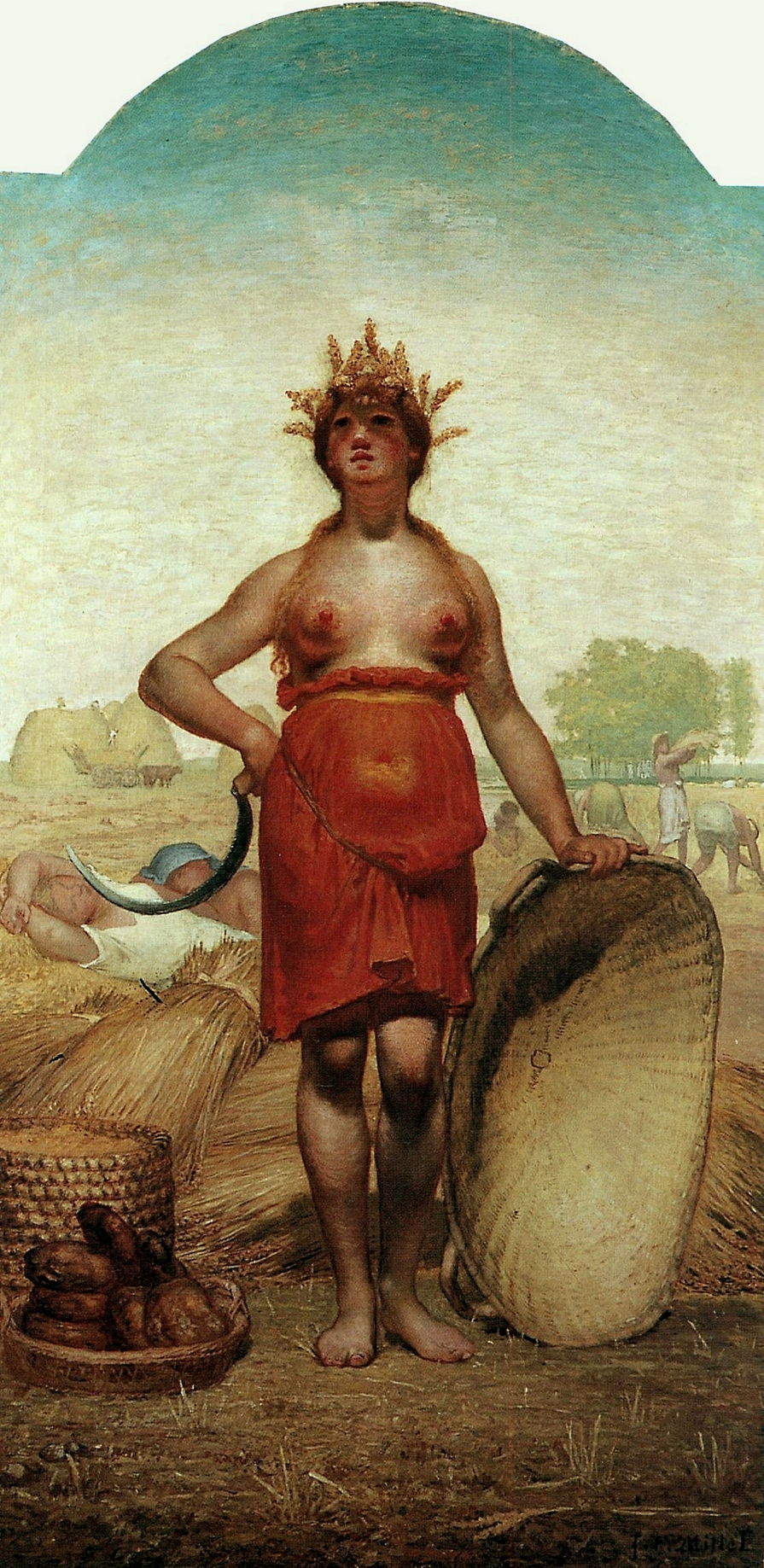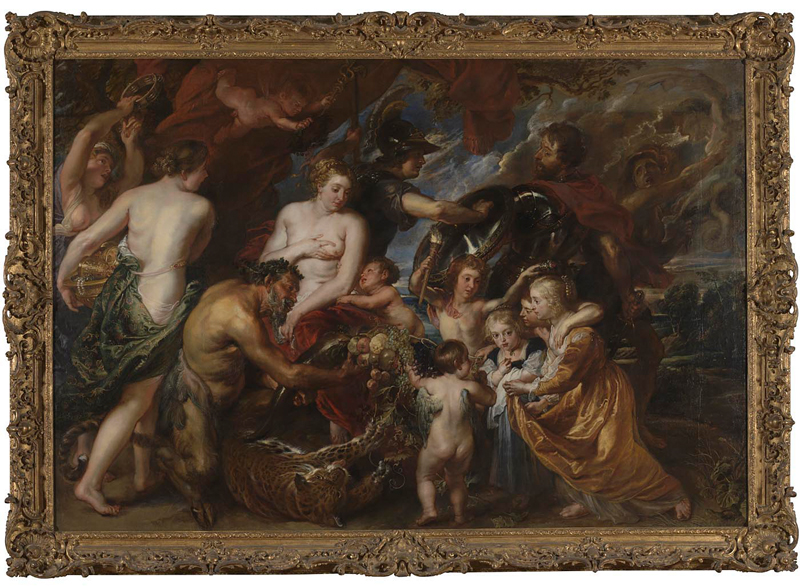Under her Greek identity, Demeter (Δημήτηρ) is a rare find in paintings, where she is almost universally known as the Roman goddess Ceres, who’s so famous that she has been assimilated into English in the word cereal, which refers to her most universal attribute of grain. The sister of Poseidon, Zeus and Hera, her parents are the primordial deities Kronos and Rhea.
Demeter/Ceres is the goddess of the harvest, and of agriculture and food production more generally, extending to fertility of both plants and animals, including humans. Her attributes are ripe sheaves of wheat and the bread derived from it, and she is sometimes seen with a cornucopia or harvest spread, or feeding an infant at her breast, reflecting her association with fecundity and nutrition. Although most often seen as part of summertime allegories, she can be invoked in the early phase of the growing seasons, the Spring.

This is shown in Antoine-François Callet’s allegory of Spring (c 1781). The central figure of Flora bares her breasts with a rather effeminate Zephyrus under her left arm. At the lower right are the three Graces, dancing with their hands held high, and at the lower left is Ceres, in her chariot drawn by lions. Together with her daughter Persephone (of whom more later), Ceres is often allied with Flora in their common association with plant growth and fertility.

In the mid-1860s, Jean-François Millet developed some seasonal themes to soften the social message in his paintings. Ceres (The Summer) (c 1864-65) is a classical mythological portrait. Ceres stands, her breasts swollen and ready for lactation, her hair adorned with ripe ears of wheat, a sickle in her right hand to cut the harvest, and a traditional winnow (used to separate the grain from chaff) in her left hand. At her feet is a basketful of bread, with ground flour and cut sheaves of wheat behind. The background shows the wheat harvest in full swing, right back to a group of grain- or hay-stacks and an attendant wagon in the distance.
Ceres was a favourite with Peter Paul Rubens, who painted her in small groups and in his crowded Minerva Protects Pax from Mars (Peace and War) from 1629-30.

This painting, now in the National Gallery in London, features more than a dozen figures drawn from classical myths. Its central figures are those of Ceres, here in the role of Pax (the personification of peace), and Minerva, behind her. In attendance are Mars, Hymen, Plutus, and Alecto, with sundry Bacchantes, a Satyr, putti, and the attributes of Bacchus and Mercury. It’s like an away day from Olympus, or part of an index to Ovid.

Rubens shows Ceres expressing milk from her left breast, which arcs into the mouth of her son Plutus, the god of wealth, who is grasping her left arm.

Those figures of Ceres and Plutus are almost identical to those of Venus and Cupid in Rubens’ later Venus, Mars and Cupid (c 1633). Cupid is shown here with wings, and his traditional bow and arrows. In Peace and War, the infant is clearly not Cupid as he has neither wings nor bow and arrows, so must be Plutus.
Ceres stands for values which are strongly associated with the benefits of peace – bread rather than starvation, fertility rather than barrenness and pestilence. Her son Plutus represents the growth of wealth during times of peace.
The most prominent of Ceres’ children is Persephone, the Roman Proserpine, whose father was Zeus. When Hades (Pluto) abducts the yound Persephone as she is playing and picking flowers at an idyllic spot by Lake Pergus, Ceres starts to search for the girl. As it’s getting dark, and the goddess is growing weary and thirsty, Ceres knocks on the door of a humble cottage to slake her thirst.
An old woman, Hecuba, answers the door; while Ceres is drinking, a passing boy laughs at her and calls her greedy, for which Ovid tells us that he was transformed into a spotted newt.

Adam Elsheimer is one of the very few artists who have been diverted by this side-story, in his wonderful nocturne Ceres at Hecuba’s Home from about 1605. The young boy is mocking Ceres quenching her thirst during her search for Persephone, for which he is about to be turned into a newt.
When Ceres is unable to find her daughter she is besides herself with grief, and rends her hair and clothing, destroying the local harvest in Sicily as a result. At last, Arethusa tells Ceres of Hades’ abduction of the girl. Ceres goes straight to Zeus, Persephone’s father, and pleads the case that the girl should be freed from Hades. Zeus agrees on the condition – set by the Fates – that Persephone has not eaten while in the underworld. Sadly, that proves not to be the case, and the girl is allowed to return to her mother for half of the year, during the growing seasons, and has to go back to Hades for the other half, when the earth lies barren through the winter.
Another more obscure myth involving Ceres is that of the attempted murder of Triptolemus, a key figure in the legendary story of the development of agricultural wheat. After Arethusa is transformed into an underground river, Ceres harnesses a pair of dragons to her chariot and travels to visit Triptolemus. She gives him seed, which he is to sow in unproductive land, which has never been cultivated or has long lain fallow. The young Triptolemus flies away in her chariot, and eventually comes to Scythia, where he enters the palace of its king, Lyncus.
Triptolemus provides the king with seed, promising him rich harvests from it. Lyncus is jealous, though, so entertains Triptolemus lavishly; when the young man is sound asleep, the king tries to stab him in the heart. Ceres intervenes, and transforms Lyncus into a lynx. Triptolemus became an important deity, as an assistant to Ceres in bringing productive grain crops to Europe, and for his involvement in the secret rites of the Eleusinian Mysteries.

This tondo of a red-figure Attic cup, now in the Louvre, is typical of many classical depictions of Triptolemus and Ceres, and dates from 470-460 BCE. The young deity is sat in Ceres’ special winged chariot, as she provides him with seed to be distributed to the lands around the world.

Triptolemus also assumes the same role in the left foreground of Jerzy Siemiginowski-Eleuter’s splendid Allegory of Summer (1684—86), made as a ceiling painting for the bedroom of King John III Sobieski of Poland.
The goddess is in the centre foreground, handing an unusual blue floral wreath to Triptolemus. Above him is an allegory of the night, with the figure of Aurora-Astraea, who was modelled by Queen Marysieńka (Marie Casimire Louise de la Grange d’Arquien), wife of King John III Sobieski of Poland (1629-1696).
Low in the sky is the ‘dog star’, which is generally visible across Europe through the summer. Above is the chariot of the sun, which is in the constellation of the lion, Leo. These symbols of summer are coupled with the more obvious signs of harvest, to complete the elaborate seasonal allegory.

Károly Brocky’s Ceres and Triptolemos from about 1853 is a simpler evocation of these gods and their roles in productive agriculture, which uses a quiet form of multiplex narrative. In the foreground, Ceres is bidding the young Triptolemus to sow seed from the bag carried by a young child, who may be Plutus. In the background the harvest is also in full swing, many months after that seed would have been sown.
The Eleusinian Mysteries are inevitably mysterious, and hardly elucidated by paintings. I close with one unusual work which refers to them, and their sacred tree, which transferred into tree lore across northern Europe.

Francisco Pradilla’s Under Ceres’ Sacred Tree (1903) explores some of the mythical associations of Ceres and the Eleusinian Mysteries. This shows a party of ecstatic young women worshippers at a shrine to Ceres on an ancient hawthorn tree – a wonderful flight of fancy perhaps inspired by the artist’s travels in Italy.

